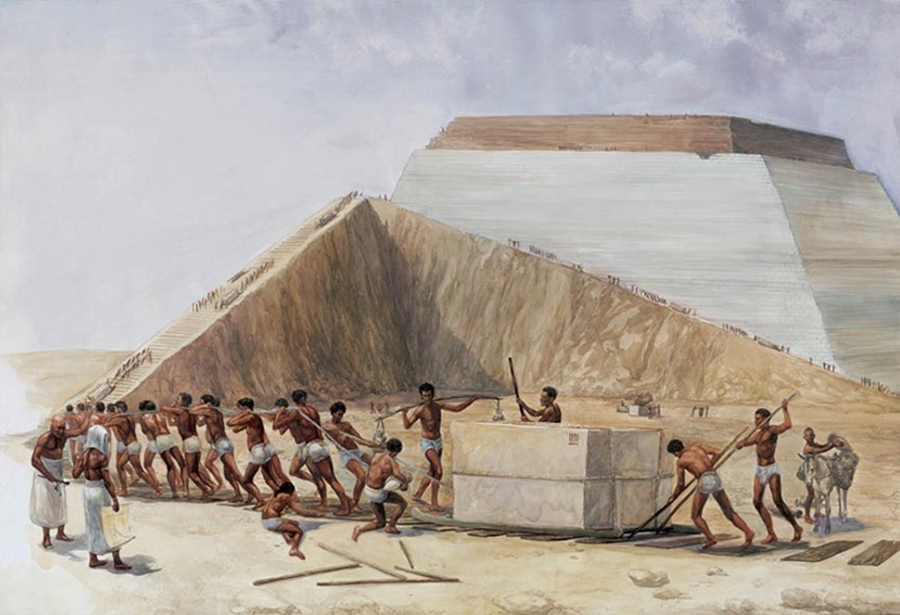

By the beginning of the First Dynasty, if not earlier, the mound of sand and rubble heaped on top of a grave, perhaps initially as a marker, had become associated with the primordial mound of creation.
Out in the desert at Abydos, the first kings of Egypt were buried in deep brick-lined tombs topped with square or rectangular mounds of sand which Egyptologists call 'mastabas', due to their resemblance to the benches that once stood in front of modern Egyptian village homes. So important was the mound over these royal tombs, that by the middle of the First Dynasty, the builders constructed two of them.
One was placed underground, supported by a retaining wall, directly over the stout roofing beams that covered the increasingly elaborate tombs. The second mastaba, encased in a mud-brick wall, was placed above ground, directly over the first. Clearly the early kings had come to see that various chaotic forces, such as rain or flash-floods and wind storms, could destroy the burial mound and interrupt resurrection much in the same way they feared chaos could interfere with the actual cycle of cosmic creation.
The upper mastaba was designed to protect the lower mastaba and doubled the chances of survival in this world and the next. This reinforcement and multiplication of the mound later played a part in the genesis of the pyramid.
With each generation the royal tombs became more elaborate, containing a huge number of sumptuous offerings and surrounded by the graves of wives, household retainers, servants and even pets. The largest and the last royal tomb to be built at Abydos is that of King Khasekhemwy, the last king of the Second Dynasty who ruled Egypt to about 2686 BC. Since 1995 Dr. Gunter Dreyer of the German Archaeological Institute has been re-investigating his tomb, clearing away the sand that has covered it since its initial excavation a century ago. Completely unlike the tombs of his predecessors, Khasekhemwy's tomb is trapezoidal in shape and impressively large. In a trench dug deep in the sand, it was constructed of mud brick and measures almost 69 m (230 ft) in length, varying in width between 17.6 m (56 ft) and 10.4 m (33 ft).
After two seasons, Dreyer has succeeded in clearing again the first part of the tomb, which was made up of thirty-three storage rooms for offerings and funerary equipment laid out in three rows. His careful study of the architectural remains has revealed a fascinating story of structural collapse which protected valuable burial equipment from the robbers who burrowed through the walls to get at it; further large-scale pillaging was followed by pious restoration in the Middle Kingdom, many centuries after the tomb was built.
However, Dreyer has yet to reach the really interesting part of the tomb, the burial chamber - a room built entirely of dressed stone blocks. At the time of its initial discovery, this chamber was the earliest stone construction then known, and, although earlier examples of stone masonry have since been found, Khasekhemwy's remains the finest of its age. New research suggests it is but a mere hint of what he was capable.
While such tombs were the private chambers of the king for eternity, at the edge of the desert about half a mile (1 km) away each king built for himself an eternal palace of state; a place where the official and ritual business of a king could be undertaken for eternity, and where eternal tribute and nourishment would be supplied.
No doubt based on the actual palace that the king used during his lifetime, many of these massive mud-brick enclosures were decorated on their outer surface with a series of niches or recesses to create a paneled effect.
Before the invention of the cartouche to enclose a king's name, the image of the niched facade of the royal palace was used.
The king's name was inscribed as if on the lintel over an elaborately paneled gateway in a device called a serekh. Subsequently, the whole design of panels, recesses and doors became the fixed scheme for the carved stone sarcophagi of royalty and the elite alike throughout the Old Kingdom and later. In effect, the sarcophagus became each person's individual palace of eternity.
Khasekhemwy's is the only one of these palaces of eternity at Abydos still clearly visible. In fact, it is hard to miss. Still standing in places to its full original height of 11 m (36 ft), with walls 5.5 m (18 ft) thick, it is one of the oldest standing mud-brick structures in the world. It measures 122 m (400 ft) in length and 65 m (213 ft) wide and is surrounded by a low curtain wall.
Unfortunately, little remains within the structure to help determine how it might have functioned, since buildings of temporary and perishable materials have vanished. However, clearance of a portion of the vast enclosed space in 1988 by O'Connor and his team uncovered a large mound of sand and gravel covered with a brick skin near the center of the structure.
Its significance is not entirely clear. Perhaps it formed another 'mound of creation', signifying the presence of the king's resurrected spirit; and as such it is another step toward the birth of the pyramid. This king's ability to marshal a workforce to construct such a massive tomb and vast mortuary palace is as impressive as the structures themselves. Millions of mud bricks were involved, some of which had to be hauled over a mile into the desert to be put in place.
But Khasekhemwy didn't just build one of these palatial enclosures, he built another at Hierakonpolis. Only onethird the size of the enclosure at Abydos, it was nevertheless no mean feat, and it too still stands to its original height, a testament to its builders' construction skills. The real story of the pyramids begins here, in terms of the organizational aspect alone.
Khasekhemwy, although little known, was the first major builder among the pharaohs, but he didn't stop with the building of tombs. The accomplished relief carving on the hard stone architectural features that embellished both his enclosure and the temple of Horus at Hierakonpolis, as well as the two stone statues of himself that he dedicated there, anticipates the formal style and poses of Egyptian art which were to follow.
Khasekhemwy had taken Egypt to the cusp of the Old Kingdom, the first great flowering of Egyptian civilization. Massive constructions of mud brick and refined carving of hard stone were well within his control. But it seems that Khasekhemwy may have had even greater aspirations, further north, at Saqqara. The Old Kingdom was the great age of pyramid building in Egypt. Pyramid, would continue to be built for another 500 years, but priorities would change.
At the beginning of the New Kingdom, the pyramid form was turned over to the officials of the realm to build over their rock-cut tombs. The king had different plans.
Nearly thirty pharaohs would eventually be buried in what is now known as the Valley of the Kings. At the edge of the cultivated fields each king built his palace of eternity, or Mansion of Millions of Years as it was called, reviving a tradition dating back to Egypt's first kings.
Immortality was now reinforced by the stunning array of texts and pictures which decorated their distant tombs and was assured in the increasingly elaborate mortuary temples and temples of state, where the king was portrayed both with and as the god Amun-Ra, the chief god of Thebes. These new mounds of creation, embellished with the tribute from a far-flung empire, would become the focus of the king's creative urge, and would now speak of his power and the glory. And like the pyramids, they continue to stun and amaze. But this is far from being the end of the story.
Centuries later the royal pyramid will make a dramatic reappearance.
Many of the pyramids were built with a number of different stone materials. Most of the material used was fairly rough, low grade limestone used to build the pyramid core, while fine white limestone was often employed for the outer casing as well as to cover interior walls, though pink granite was also often used on inner walls. Basalt or alabaster was not uncommon for floors, particularly in the mortuary temples and as was mudbricks to build walls within the temples (though often as not they had limestone walls).
Egypt is a country rich in stone and was sometimes even referred to as the "state of stone". In particular, Egypt has a great quantity of limestone formation, which the Egyptians called "white stone", because during the Cretaceous period Egypt was covered with seawater. The country is also rich in sandstone, but it was never really used much until the New Kingdom.
Limestone seems to have first been employed in the area of Saqqara, where it is of poor quality but layered in regular, strong formations as much as half a meter thick. This limestone is coarse grained with yellow to greenish gray shading. The layers are separated from each other by thin layers of clay and the coloration may vary according to layer. It could often be quarried very near the building sites, and quarries have been found at Saqqara, Giza, Dahshur and other locations.
In order to quarry this stone, the blocks were marked out with just enough space in between each to allow for a small passageway for the workers to cut the blocks. The workmen would use a number of different tools to cut the blocks, including copper pickaxes and chisels, granite hammers, dolerite and other hard stone tools.
The finer, white limestone employed in the pyramids and mortuary temples was not as easy to quarry, and had to be found further from the building site. One of the man sources for this limestone was the Muqattam hills on the west bank of the Nile near modern Tura and Maasara. This stone laid buried further from the surface, so tunnels had to be dug in order to reach the actual stone quarry. Sometimes these deposits were as deep as fifty meters, and huge caverns had to be built to reach the quarry. Generally, large chunks of stone were removed, and then finely cut into blocks. The blocks were then moved to the building site on large wooden sledges pulled by oxen. The path they took would be prepared with a mud layer from the Nile in order to facilitate the moving.
Pink granite, basalt and alabaster were used much more sparingly. Most of this material was moved from various locations in southern Egypt by barges on the Nile. Pink granite probably most often came from the quarries around Aswan.
Basalt, on the other hand was not as far away. Only recently have we discovered that most of the basalt used in pyramid construction came from an Oligocene flow located at the northern edge of the Fayoum Depression (Oasis). Here, we find the worlds oldest paved road, which led to the shores of what once was a lake. During the Nile inundation each year, this lake made a connection to the Nile, so at that time, the basalt was moved across the lake and into the Nile for transport.
Alabaster is quarried from either open pits or underground. In open pits, veins of Alabaster are found 12 to 20 feet below the surface under a layer of shale which can be two or three feet deep. The rocks have an average height of 16-20 inches and a diameter of two to three feet. Much of the alabaster used in the pyramids probably came from Hatnub, a large quarry near Amarna north of modern Luxor.
However, it should be pointed out that by even the end of the Old Kingdom, there were hundreds of various types of quarries scattered across the western and eastern deserts, the Sinai and southern Palestine.
Mudbricks, of course were made throughout Egypt and were a common building material everywhere, in common homes and palaces and probably many city buildings.The better mudbricks were fired, or "burnt" in an oven, though it was not uncommon for mudbick not to be fired, and so not as durable. Unfortunately, most structures built of mudbrick have not weathered the ravages of time well. They were built using wooden forms and Nile mud mixed with various fillers.
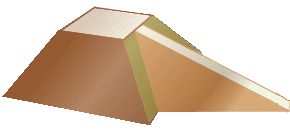 A major problem facing the builders of the Ancient Egyptian Pyramids, was that of getting the Large stone blocks to the height they required. the method shown at left, is the only one proven to have been used. The ramps were built on inclined planes of mud brick and rubble. They then dragged the blocks on sledges to the needed height. As the pyramid grew taller, the ramp had to be extended in length, and its base was widened, else it would collapse. It is likely that for the construction of each pyramid, several ramps were probably used.
A major problem facing the builders of the Ancient Egyptian Pyramids, was that of getting the Large stone blocks to the height they required. the method shown at left, is the only one proven to have been used. The ramps were built on inclined planes of mud brick and rubble. They then dragged the blocks on sledges to the needed height. As the pyramid grew taller, the ramp had to be extended in length, and its base was widened, else it would collapse. It is likely that for the construction of each pyramid, several ramps were probably used.
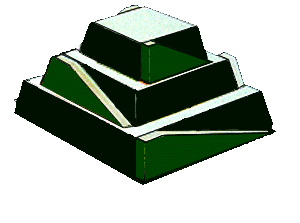 The arrangement of the ramps used for building is in much dispute. Assuming that the step pyramid was built before the outer structure, and then the packing blocks were laid on top, the ramps could have run from one step to another rather than approaching the pyramid face at right angles
The arrangement of the ramps used for building is in much dispute. Assuming that the step pyramid was built before the outer structure, and then the packing blocks were laid on top, the ramps could have run from one step to another rather than approaching the pyramid face at right angles
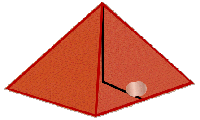 Some of the pyramids indicate an accurate understanding of Pi, but the mathematical knowledge of the Egyptians did not include the ability to arrive at this by calculation. It is possible that this could have been arrived at "accidentally" through a means such as counting the revolutions of a drum.
Some of the pyramids indicate an accurate understanding of Pi, but the mathematical knowledge of the Egyptians did not include the ability to arrive at this by calculation. It is possible that this could have been arrived at "accidentally" through a means such as counting the revolutions of a drum.
 The internal construction of most true pyramids consists of a series of buttress walls surrounding a central core. The walls decrease in height from the center outwards. In other words, the core of the true pyramide is essentially a step pyramid. The internal arrangement added stability to the structure. Packing blocks filled the "steps" formed by the faces of the outermost buttress walls and casting blocks (often Limestone) completed the structure of the true pyramid.
The internal construction of most true pyramids consists of a series of buttress walls surrounding a central core. The walls decrease in height from the center outwards. In other words, the core of the true pyramide is essentially a step pyramid. The internal arrangement added stability to the structure. Packing blocks filled the "steps" formed by the faces of the outermost buttress walls and casting blocks (often Limestone) completed the structure of the true pyramid.
Architects and builders used a different form of construction in the pyramids of the 12th and 13th Dynasties. Mainly because of economy, for it was suitable for relatively modest structures in inferior materials. Solid walls of ston ran from the center, and shorter cross walls formed a series of chambers filled with stone blocks, ruble or mud bricks. An outer casing was usually added, and although quite effective in the short term, it did not even come close to the earlier construction methods. Pyramids which were built with this structural design are quite delapidated and worn.
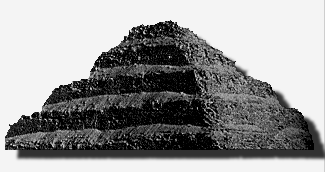 The earliest form of pyramid, the step, dates back to the 3rd Dynasty, and consists of several steps. A descending passage from the north leads to the buriel chamber. Underground galleries surround the pyramid on all but the south sides. The first, and probablythe only step pyramid ever completed, is that of King Netjerykhet Djoser at Saqqara. The Step pyramid is not near as pleasing to the eye as the True pyramid, which could explain the quick abandonment of this type of pyramid.
The earliest form of pyramid, the step, dates back to the 3rd Dynasty, and consists of several steps. A descending passage from the north leads to the buriel chamber. Underground galleries surround the pyramid on all but the south sides. The first, and probablythe only step pyramid ever completed, is that of King Netjerykhet Djoser at Saqqara. The Step pyramid is not near as pleasing to the eye as the True pyramid, which could explain the quick abandonment of this type of pyramid.
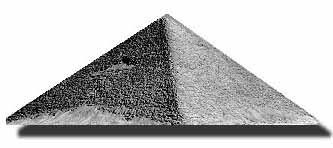 The true pyramid is a natural development and improvement on the step pyramid. The first true pyramids were introduced in at the beginning of the 4th Dynasty. The structure of a True Pyramid is virtually the same as a step pyramid. Packing blocks are stacked until the dimensions were right, and then finishing blocks (usually limestone) were the last touch. The aesthetics are much more pleasing than the step pyramid, but the construction isn't really that different.
The true pyramid is a natural development and improvement on the step pyramid. The first true pyramids were introduced in at the beginning of the 4th Dynasty. The structure of a True Pyramid is virtually the same as a step pyramid. Packing blocks are stacked until the dimensions were right, and then finishing blocks (usually limestone) were the last touch. The aesthetics are much more pleasing than the step pyramid, but the construction isn't really that different.
Before the physical orientation and layout of a new pyramid took place, considerable planning was needed under the direction of a "royal master builder". Ultimately, the responsibility fell on the vizier, who was typically the head of all royal works. The first step in the process was taken by specialists who would draw up plans for the pyramid on papyrus. After the construction began, plans and sketches were drawn on papyri or flat slabs of limestone. Planners even made models of their projects, as evidenced by a limestone model of a substructure found in the Pyramid of Amenemhet III at Dahshur. After the planning stage, each step of pyramid building was initiated with foundation rituals.
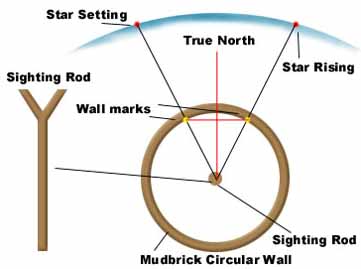
Pyramids, unlike many other types of religious structures, required strict orientation to the cardinal points. Pyramid alignment may have been carried out through a number of different means, including some methods we have probably never thought of. The primary theory of how the ancient Egyptians oriented most any building that had to conform to true primary coordinates has been by stellar measurements. This involved building a small, circular wall of perhaps mudbrick that had to be perfectly level at the top. Within the circle, a man would stand and through a straight pole with a forked top called a bay, sight a circumpolar star as it rises. A second man at the perimeter of the small circular wall would then "spot" the wall where the star rose. Using a type of plumb line, or merkhet, he would also spot the mark at the bottom of the wall. When the star set, the process would be repeated. Measuring between the two spots would then provide true north from the center sighting pole.
Recently several other theories have been raised, all of which involve some sort of astronomical measurements. A British scholar named K. Spence believes that the Egyptians used two circumpolar stars (Delta Ursae Majoris and Beta Urae Minoris or Epsilon Usae Majoris and Gamma Urae Minors) Another theory set out by a Slovak Egyptologist, D. Magdolen, believes that the ancient Egyptians oriented their monuments using the sun, by means of wooden stakes and ropes. There is in fact a reference in ancient text referring to "the shadow" and the "stride of Ra".
The sun rises and sets in equal but opposite angles to true north. Using a plumb line, a pole would have been set as vertically as possible. Then, about three hours before noon, its shadow would be measured. This length then becomes the radius of a circle. As the sun rises higher, the shadow shrinks back from the line and then becomes longer in the afternoon. When it reaches the circle again it forms an angle with the morning's line. The bisection of the angle is true north. However, this method would be less accurate then the stellar method, but could be fairly accurate during the solstices.
After the primary coordinates were determined, the ground plan would be marked out. Some of the methods used to do so varied from pyramid to pyramid. Here, we examine the means by which the ground plan of the Great Pyramid of Khufu at Giza was determined.
Initially, a reference line along true north was constructed from the orientation process. The next step would be to create a true square with precise right angles. Within Khufu's pyramid, there is actually a massif of natural rock jutting up that was used as part of the pyramid's core. Therefore, measuring the diagonals of the square to check for accuracy was impossible.
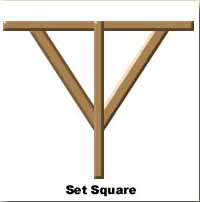
The ancient builders could have achieved a precise right angle in any of three ways. The first method would have involved the use of an A-shaped set square. The set square would have been placed along the established orientation line and the perpendicular taken from the other leg of the square. The set square would then be flipped and the measurements repeated. The exact 90 degree angle would then be taken by taking into account the small error of the angle between the two measurements.
The problem with this method is that no set squares large enough to give a precise angle for the distances have been found in ancient Egypt. The perpendicular measurement it provides would be very short considering that the line would have to be extended some 230 meters (754 ft) in the case of Khufu's pyramid.
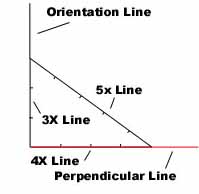
A second method would have employed the use of a sacred or Pythagorean triangle. The triangles seem to be present in the design of the Old Kingdom pyramids, but there is no real conclusive evidence of their use. Basically, this triangle uses three equal units on one side, four on the next, and five on the hypotenuse to give a true right angle. At Khufu's pyramid a series of holes along the orientation line are dug at seven cubit (3.675 meters or about 12 ft) intervals, so the triangle probably used these positions in the measurement. In other words, the triangle would have been measured as 21 cubits by 28 cubits with a 35 cubit hypotenuse. This would have resulted in a much longer measurement for the perpendicular line then with the use of a set square. If the unites used were any greater, the measurement would have been interrupted by the rock outcrop.
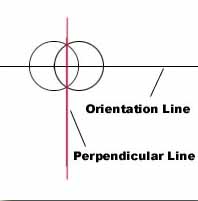
A third method possibly available to the early Egyptians would have been through the use of intersecting arcs. In this method, two circles would have been sketched by rotating a cord around two points on the orientation line. The intersection of the two circles would then provide a right angle. Some doubt this method was used because the elasticity of the string or rope used to sketch the circles would lead to inaccuracies. However, at Khufu's pyramid, there are a number of post holes dug that might have been used to draw such circles, so the method cannot be ruled out.Furthermore, the Egyptian may have used a rod or other device rather than rope or string to draw the circle, eliminating elasticity.

An orientation reference line was set up in a larger square by measuring off the established square ground plan. This was done by digging post holes at measured distances from the inner square in the bedrock and inserting small posts through which a rope or string ran. These holes were dug at about 10 cubit intervals. This outer reference line was needed because the original orientation lines would be erased by building work. Various segments of the reference line could be removed so that building material could be moved into place. Then measurements were taken from the guide line as the material for the platform were put in place so that the the platform was in accord with the initial floor plan.
The platform of Khufu's pyramid was made of fine white Turah quality limestone slabs with occasion backing stones of local limestone for leveling. Today, we know that the platform was one of the most important elements to a pyramid's survival over great lengths of time. It also appears that the builders of Khufu's pyramid were well aware of this, but such knowledge seems to have been almost forgotten from time to time. Some later pyramids platforms were not built upon solid bedrock, or the platform was poorly built and those pyramids built atop these poorly constructed platforms did not survive for long.
Not only was the platform required to be laid in a perfect square, but it was also required to be very level. In Khufu's pyramid, the platform is level to within about 2.1 cm (one inch). There were several means that this too could be accomplished. Traditional though, apparently originally conceived by Edwards, suggests the use of water to level the platform. He thought that the ancient Egyptians might have built a mud enclosure around the platform that was then filled with water. A grid of trenches would have been cut at a uniform depth below the water. However, modern Egyptologists believe this method would have been cumbersome at best. The platform would have had to have been chiseled beneath the water. Perhaps a more accepted theory involves channels being cut to form a grid within the platform, which was then filled with water. At the top of the water's surface, the level would be marked along the sides of the channels, and then the platform cut accordingly.
However, Mark Lehner, who must be taken very seriously in any discussion of Giza pyramids, does not believe that water was used to level Khufu's pyramid. In fact, he doubts any water related theories of leveling, mostly because evaporation might cause considerable variations in the measurements. Specifically though, Khufu's pyramid is built on a sloping base, and here, it is the platform itself that is leveled and not the bedrock beneath the platform. In fact, the ancient builders were required to cut down the northwest corner of the platform, while actually building up the opposite, southeast corner.
Another leveling method might have utilized the posts used to build the reference line of the pyramid. These posts could have been made of equal heights, or marked to provide a reference level. Apparently the leveling techniques used in pyramid construction are not well understood at this time.
However, what is understood is that when the Egyptians, such as those who built Khufu's pyramid, were at the top of their skills, the monuments they built could indeed last virtually forever.
Most all of Egypt's best built monuments, the ones still around for us to see today, were somehow related to religion, and all construction of religious buildings in ancient Egypt began with ceremonies of very ancient origin. Today, we call these foundation rituals. The rituals involved leaving a foundation deposit buried not only under the corners of, for example, a temple, but sometimes at the apex and even at the corners of individual halls, courtyards and shrines as well as underneath pylons, columns and obelisks. They have been a valuable source of information for Egyptologist throughout the years.
However, the foundation ceremony consisted of much more then leaving the foundation deposits. Comparison of text and other material indicates that the ceremony actually consisted of ten discrete rites. These were, in theory, personally conducted by the king himself assisted by various deities and part of the rites occurred at the beginning and end of construction. The rites included:
1. "Stretching the Cord", thereby fixing the plan of the building.
2. Purifying the area to be built upon by sprinkling gypsum.
3. Digging the first foundation trench
4. Filling the foundation trench with sand
5. Moulding the first brick or bricks
6. Burying the foundation deposits
7. Initiation of the building work
Completion of Construction
8. Purification of the completed temple
9. Presenting the temple to the deities to whom it is dedicated
10. Offering of sacrifices
During the Greek (Ptolemaic) period, a ceremony was even made of the king leaving his palace and arriving at the temple site, but the above list sets out all the rites of the earlier lists such as that depicted on the walls of the Small Temple of Tuthmosis III at Medinet Habu.
The first of these rituals became, over time, the most important. Known as pedj-shes, or "stretching the cord", it was of such importance that the whole ceremony, or at least that section leading up to actual construction, was called by the same name. The reason this rite was so important was that it aligned the whole temple by careful astronomical observation and measurement.
This was probably done by sighting northern circumpolar stars through a notched stick called a merkhet. This was perhaps accomplished by sighting the star on an artificial horizon as it rose in the evening, and again as it set. Determining the halfway point between these two points would give the builder's true north.
Theoretically, the king carried out this ritual with the aid of Seshat, or Sefkhet-Abwy, the scribal goddess of writing and measurements. In reality, trained temple personnel probably carried out the measurements and the king's role was probably purely symbolic. In fact, while we do not know how often the king actually participated in the rites, symbolically at least, all stages of a temple's construction were performed by him.
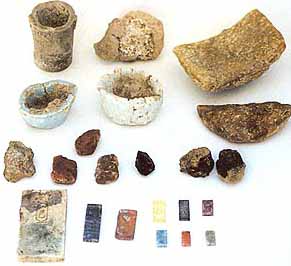
After the initial phases of the ceremony were completed, the foundation deposits would soon be placed in a pit that was sometimes lined with brick. These pits could be as large as several meters across. Their composition varied widely, but often included small votive plaques, bricks, models of building tools or good offerings, and often the head of a bull and a goose. These objects were normally models of a purely symbolic nature. The items were most often made of clay, wood or other simple materials and were rarely of expensive or rarer substances. In the Late Period, they sometimes also included samples of materials actually used in the building's construction.
Normally, these items were not even inscribed, but when they were, mostly during the Middle and New Kingdom period, they usually only stated the name of the king who commissioned the construction and perhaps the deity to whom the temple was dedicated. These inscriptions usually followed a formula such as "The good king (King's name) beloved of (Deity's name) Lord of (City or Temple name). In the 12th Dynasty, we also find "Excretion Text" listing the enemies of Egypt written on figurines and pottery, and buried beneath the construction so that they were symbolically "smothered".
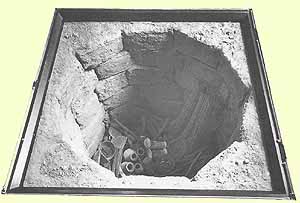
The most famous example of a foundation deposit is probably those found in the temple of Hatshepsut at Deir el-Bahri. This temple had fourteen brick lined pits measuring about one meter in diameter and between 1.5 and 1.8 meters in depth. Each was placed at a crucial junction in the plan of the temple. The contents included food offerings and materials used in the construction of the temple. They also held scarabs, cowroids, amulets, travertine jars and models of tools, such as crucibles and copper ore, lead ore and charcoal for smelting). The introduction of model tools and building materials within the deposits were meant to magically serve to maintain the building for eternity.
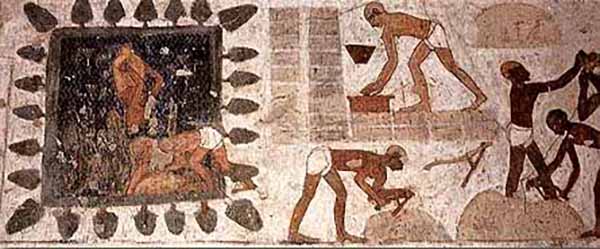
When one thinks of Egypt, one's mind is generally drawn to the vision of the three monumental Pyramids and accompanying Sphinx that stand on the Giza plateau near modern Cairo. If one travels to Giza, one will probably learn that there were subsidiary pyramids for the great wives, and remnants of the temples connected to the pyramids.
One might wonder how these wonders were built, visions of the various Hollywood versions of the constructions, with thousands of foreign slaves huddled under the whips of cruel overseers, dancing through one's brain.
Such was never the case. There were slaves to be sure, throughout the Near East. Slaves acquired as prisoners of war, slaves made due to debt. But the pyramids were monuments of the Kings, monuments to their connection with the gods, to their ascent into the afterlife with the gods. The pyramids and their temples were part of the royal cult, and required the dedication and devotion of craftsmen and laborers who believed in their King and their gods. Slaves there may have been. But the pyramids were built by Egyptians, by stonemasons, artisans, artists and craftsmen. While skilled craftsmen and management staff worked year round, farmers would come from the provinces during the inundation period to do the heavy work.
The closest thing to a capital city in Old Kingdom Egypt was the residence of the king and his court. A royal residence may have been the heart of a pyramid town during construction. If the royal house moved to Giza, then its butchers, officials, bakers, and others would have moved with it.
Archaeologists and experts are uncovering the very village in which these people lived. Excavations at Giza have taken place less than 1000 feet south of the Great Sphinx, just south of the gigantic stone Heit el-Ghurob, Wall of the Crow. The Wall of the Crow is a large stone wall built to separate activities of the mortuary cult from everyday activities. It may have served as the ancient gateway into the necropolis. The wall was 33 feet high and more than 40 feet thick at its base. The gateway alone is 23 feet high and capped with three large limestone lintels.
To the south of the Giza pyramids lies a tract of land about 39 acres, as yet untouched by the suburbs of modern Cairo. The major part of the settlement spreads out along the eastern base of the plateau, now under Cairo itself. The industrial area is west of that, in the low desert south of the Great Sphinx. The cemetery area is just west of the industrial area and higher on the slope. 300 tombs have been found, many, small-scale copies of the royal pyramids and great stone mastabas of the nobles. In the South Field, from 1971 to 195 were found bone, ash, potsherds, flint, stone bowls and mudbrick seals of Khufu and Khafre.
The first discovery was a rectangular building with a series of pedestals along each wall. Then mud sealings turned up mentioning the wbt or embalming place of Menkaure, the builder of the third pyramid.
Behind Khafre's pyramid runs a series of long galleries. Flinders Petrie surveyed the Giza Plateau in 1880-1882, and believed these to be the remains of barracks housing the pyramid workers. But he could not carry out any detailed excavation, and recent efforts have turned up none of the usual debris associated with living quarters. It is now thought that the galleries were more likely to have been workshops or storerooms associated with the royal mortuary cult.
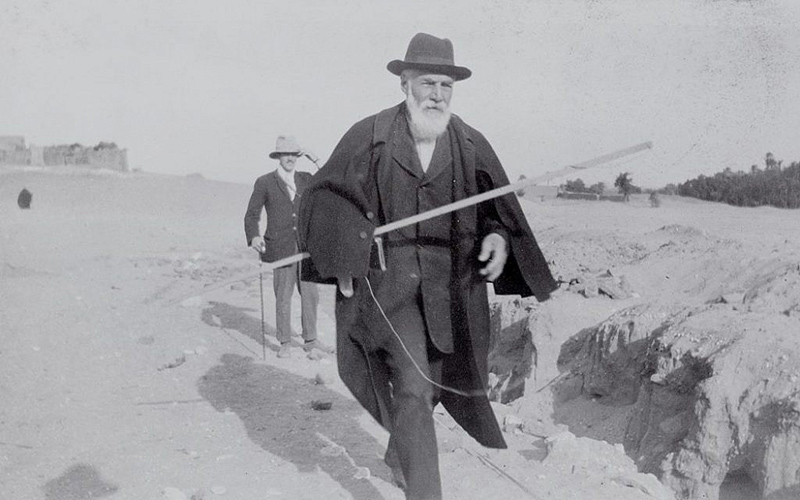
In the early 20th century George Reisner - father of American Egyptology - excavated a series or rather run-down Old Kingdom mud-brick houses in the area around Menkaure's valley temple. These turned out to be the homes of those who served the royal cult after the building had ended. Houses in the ancient town excavated by George Reisner were built of mudbrick and some had wooden roofs.
To build and maintain the pyramids an enormous support system must have existed. Production, facilities for food, pottery, building materials, and supplies, storage depots, and housing for the workmen and those responsible for servicing the pyramid temples were necessary. Evidence of a sewage system was uncovered. The oldest known paved street, with drainage facilities, and the oldest known hypostyle hall have been found here.
Since the reign of Sneferu, an entire town was associated with each pyramid, full of people employed to maintain the king's afterlife. New villages and agricultural estates were founded, specifically to supply the pyramid cult and those who worked for it. This flow of resources from the peripheries to the pyramids and thus to the very center of the state was responsible for making Egypt into the most powerful centralized nation of its time.
Years later when work resumed, a huge trench was dug out to the east of the wbt building. Wbt refers to embalming workshop and all institutions connected with supplying funerary goods.
Thousands of potsherds dating from the time of the pyramids were removed, but also, two intact bakeries were found. Large bell-shaped pots in which the bread was baked still littered the floor. Vats and molds, and areas for sorting salted fish and metalworking, were also found. Many of the goods used were probably imported from the vast estates owned by the complex. Sneferu's 35 estates, listed in the valley temple of his Bent Pyramid, were sited in Middle Egypt.
A chamber for working copper was found, evidenced by copper slag, small furnaces and much ash and charcoal. 65 feet away, a small structure that resembled a simplified version of workers' houses from other sites and periods was also found.
The bakery was attached to a larger building. Low benches and troughs lined with clean desert clay filled the room. Carefully scraping back the deposits on the floor, the detritus was found to be the gills, fins, cranial parts and vertebrae of fish. The building had been a cat-fish processing center, perhaps the institution called per shena ('commissariat') in hieroglyphics texts and tomb scenes.
One of the very curious findings in all the workshops is the vast quantities of wood ash being uncovered, in the bakery, in the copper workshops, and in the fishery. One wonders how large the importation of wood into Egypt was at this time.
From hieroglyphics, inscriptions and graffiti, it is being learned that skilled builders and craftsmen probably worked year round at the site. They built their tombs near the pyramids, and placed statues and other objects inside in preparation for the afterlife. The mud-brick tombs had a variety of shapes: mini-pyramids, step pyramids, mastabas and beehives. The tombs of the pyramid builders have also been found, when a tourist's horse stumbled and punctured what turned out to be the intact vaulted roof of a tomb.
Hieroglyphs scrawled on the false door identified it as belonging to Ptah-shepsesu and his wife. The tombs of those who worked under Ptah-shepsesu are arranged all around his tomb, beneath miniature mastabas of their own. An additional 600 more graves have been found grouped around the thirty larger graves of their superiors.
The Upper Cemetery has unique tombs of limestone and mudbrick, larger and more elaborate than the ones in the lower part. Two tombs were fronted by a long causeway, built of stone rubble, with an offering basin at the end. Titles found included "inspector of building tombs" and "overseer of the craftsmen."
In the slope immediately above, tombs of dressed stone belong to the wealthier class. The owners bore titles such as Director of the Draughtsmen, Inspector of the Craftsmen, and Overseer of the Masonry. One man named Nefer-thieth had a beautiful chapel carved on one wall with scenes of the owner and his family. He had two wives and eighteen offspring. His chief wife, who had borne eleven of the children, was a weaver. A large number of scenes depicted the making of bread and beer, so Nefer-thieth may have supervised a bakery. His wife's funerary offering menu depicts fourteen different types of bread and cakes.
Behind and to the west of a large tomb that belonged to an "Overseer of Tomb Builders," family burial shafts, painted false doors and the meager graves of the workmen who labored under the overseer were excavated. Titles such as "Inspector of Royal Tombs, " and "Buidling Director" were found inscribed on these tombs. Women buried in this cemetery bore titles such as "Priestess of Hathor."
Larger and finer tombs built of limestone have been found higher up the slope. To the north of one of these tombs is a serdab or statue chamber, which contained four well-preserved statues.
Many tombs, most less than a few feet square, were made of mud, rubble and leftover stones from the pyramid construction. Some have miniature false doors, and in some, statues were found. But most are anonymous and without grave goods, and the bodies were not mummified. The bones speak of arthritis and degenerative joint disease, particularly in the back. Analysis of skeletal remains shows the average age at death was between 30 and 35 years. Bones of both men and women show evidence of heavy labor. Degenerative arthritis occurred in the vertebral column, particularly in the lumbar region, and in the knees.
The level of medical care was high. Evidence of brain surgery was found in one man, others had broken hands treated by binding. One workman had his leg amputated and lived 14 years more thereafter. Syphilis was found in yet another skeleton.
Work progresses in the village. Traces of a palace may have been found, proving that the royal residence may have stood here. As more remains are uncovered, an entire new picture of the life in the Old Kingdom will appear.
When many of us were young, we were taught that the great pyramids required immense human resources to build, which of course, they did. We were told that as many as 100,000 slaves worked as forced labor for decades to build the Great Pyramid at Giza. Regrettably, it would seem that our teachers needed something to say about this ancient Egyptian civilization, and as is not unusual, memorizing some sort of data outweighed the importance of having correct information. Hence, we committed to memory the fantastic estimates of ancient historians who were mystified by the large volumes of material required to build these great stone edifices. However, we must give them credit, for at least they did not degrade the accomplishments of the early Egyptians by proposing the builders of these great structures to be space aliens or Atlanteans.
To many, the sheer size of the pyramids made such overestimation seem reasonable. Wieslaw Kozinski, a Polish architect, believed that an average of 25 men were required to transport a block weighing one and one-half tons. Therefore, at a time when Egypt's population was probably no more than one and a half million people, including women and children, he estimated a workforce of 60,000 men outside the construction site and as many as 300,000 inside. Of course, Kozinski believed that the population of Egypt during the early pyramid age to be five to ten million people.Yet modern research has demonstrated that as few as eight to twelve men could have actually pulled a 2.5 ton block over an even, lubricated (by water) surface, and twenty men could have drug such a block up a lubricated gradient from the quarries to the Great Pyramid in as little as 30 minutes.
Even Petrie, one of the first great modern Egyptologists, thought that the huge labor force the Greek historian Herodotus reported (100,000 men) to have been used for the construction of the Great Pyramid was plausible. In his view, which continues to have considerable acceptance by today's Egyptologists, the labor force was drawn mostly from the rural Egyptian population who would work on the monuments during flood season, when they could not work in their fields. It is probably not unreasonable to believe that a few slaves were also involved in this construction work, though to what extent we do not know.
It seems that the more knowledge we gain about the pyramids and other elements surrounding their construction, the lower the estimates for the work force. Kurk Mendelssohn, an American mathematician and physicist believed there were as many as 50,000 men involved with the Great Pyramid's construction based on calculations needed to move a given mass over a given distance. Ludwig Borchardt and Louis Croon, in their investigations, estimated that the Meidum pyramid would have required some 10,000 men to complete. Applying these calculations to the larger Great Pyramid, they estimated that a work force of some 36,000 men would have been required for that project. However, even this smaller workforce seemed too high to them, given the limited area of the construction site and the difficulties connected to logistics support.
More recent evidence suggests that the ancient Egyptians may have been somewhat more astute builders. In the mid 1980s a French/Egyptian team investigated the Great Pyramid using ultrasound technology. Their efforts revealed that large cavities within the structure had been filled with pure sand. This is referred to as the "chamber method", and could have considerably increased the pace of work. In addition, we also know that the Great Pyramid utilized a rock outcropping as part of its core. These discoveries, as Miroslav Verner notes, made all the careful calculations and estimates concerning how many millions of stone blocks make up the Great Pyramid, and the associated speculations, useless.
Today, while the question of exactly how many men it would have taken to build the Great Pyramid at Giza remains unanswered, we can speculate on certain elements of the workforce. The ancient Egyptians became great labor organizers. Part of the labor force working on the pyramids would have been organized as a crew, perhaps consisting of 2,000 men. This crew was divided into two gangs of 1,000 workers, which in turn was divided into five zaa (in each gang), a term that was translated by the ancient Greeks as "phyloi" or phyle, meaning tribe, group or brotherhood. Each Phyle consisted of about 200 mean.
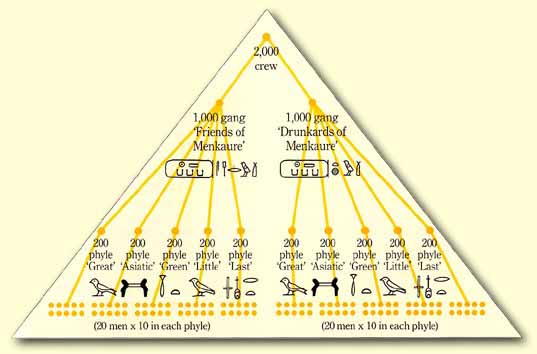
These phyle were named for the different parts of a boat, including the Great (or Starboard), the Asiatic (or Port), the Green (or Prow), the Little (or Stern), and the Last (or Good) Phyle. The name of the fifth phyle is uncertain, but may have referred to the helmsmen's position. It should be noted that even the priesthood was arranged in a similar fashion. These phyle were then divided into four, or later, two smaller groups that also had names , usually related to their geographical origin, or sometimes related to the required skills or virtues of the workers.
According to Verner, there were apparently, at any one time, no more than three phyle comprising six hundred men, working on the Great Pyramid. However, Lehner seems to believe that an entire crew of 2,000 men would have been employed. While we know of the organization of this work force, we know less about what they actually did. Most Egyptologists believe they were involved with transportation and various other logistical supply work.
Verner also tells us that a second type of team system was employed. These workers were divided up according to the cardinal compass points, north, south and west. There was probably a forth team that was not referred to as the eastern team, because east, like left, was considered by ancient Egyptians to be a sinister direction. These four teams made up a "troop", and included the craftsmen and specialized workers on the pyramid construction sites. Unfortunately, there is no real evidence of the number of men making up the troop or the various teams.
It is possible, or even probable that these two types of construction teams may have been largely made up of a relatively skilled, permanent royal work force. However, it is clear, given the volume of work required to construct the Great Pyramid, that more workers were needed. These workers were probably helpers, and if slaves were used at all, they would have probably been included in this larger workforce. However, many of these helpers were probably unskilled agricultural workers employed on a seasonal basis during the Nile inundation.
We do know much more about the work activities, particularly at Giza, then ever before. Archaeologists have carefully studied the worker's villages, the craft shops, the bakeries and other related structures, which of course give us some idea of the workforce. So how many people did it take to build the Great Pyramid at Giza? Verner tells us that the current consensus among Egyptologists sets the figure at a little more than 30,000. Lehner, who has worked at Giza for many years and conducted experiments on building pyramids, is considered one of the leading authorities on these structures.
He claims a somewhat lower estimate, including carpenters to make tools and sledges, metal workers to make and sharpen cutting tools, potters to make pots for food preparation and hauling water for mortar and other purposes, bakers, brewers and others, consisting of between 20,000 and 25,000 workers at any one time. In fact, as the pyramid grew, fewer and fewer men were probably required, for work at the top required much less stone and the construction space became more limited. This number of men, which was probably drastically reduced during the agricultural seasons, probably finished the Great Pyramid of Khufu in less then 23 years.
This discussion has mostly focused on the Great Pyramid of Khufu which, simply because it was the largest pyramid we know of that the Egyptians built, seems to pose the greatest problems. Of course, we also know much more about it than many other pyramids. However, it should be noted that some of the earlier and many of the later pyramids would have required much less labor. Most, of course, were smaller, and at least a few built prior to the Great Pyramid used a more gentle slope, hence requiring less material. A number of pyramids, like that of Khufu, used rock outcroppings in their construction, and most, including Khufu's pyramid, had some "fill" material. Later pyramid's employed the use of mudbrick in their cores, so the labor required to build these pyramids was considerably reduced.
All of this discussion is not to say that the early Egyptians did not commit considerable resources to these building projects. It is estimated that during the century and a half composing the 4th Dynasty, some nine million cubic meters of masonry was utilized in royal construction projects.Essentially, the Egyptians became the world's best construction managers, and these skills served them well for some 2,500 years.
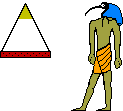
Statistics and Facts